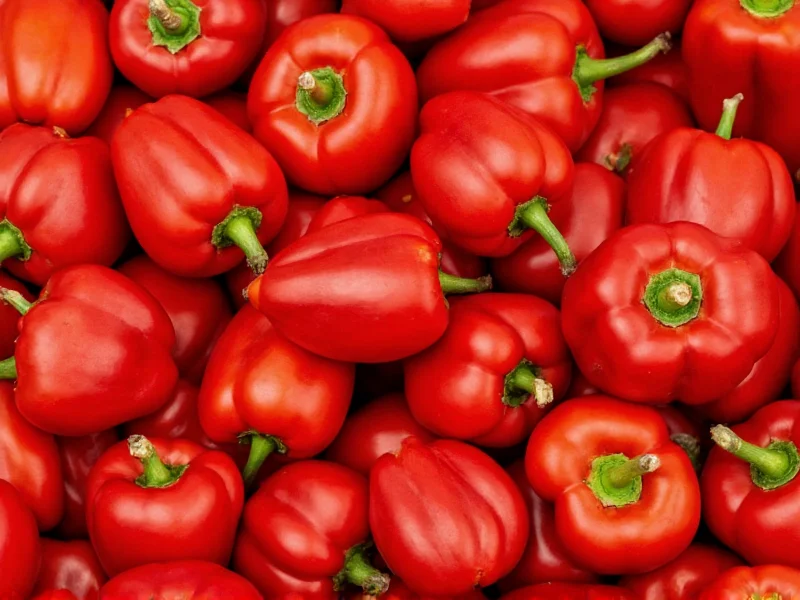Understanding what paprika is made out of reveals why this spice has become essential in kitchens worldwide. Unlike many commercial spice blends, authentic paprika contains only one ingredient: dried and ground peppers. This simplicity allows the natural characteristics of the peppers to shine through in your cooking.
The Pepper Varieties Behind Paprika
While all paprika originates from Capsicum annuum peppers, specific cultivars determine the final product's characteristics. Sweet paprika typically comes from large, thick-walled sweet peppers with thin seeds. Hot paprika varieties use smaller, thinner-walled peppers with higher capsaicin content. The most prized Hungarian paprika, for instance, derives from specific cultivars like édesnödi and kúlonás that produce distinct flavor profiles.
Contrary to common misconception, paprika isn't made from bell peppers alone. While some sweet paprika varieties incorporate bell peppers, traditional paprika uses specific pepper types bred for spice production rather than the common bell peppers found in grocery stores. The peppers selected for paprika production typically have thinner walls and more concentrated flavor compounds.
From Farm to Spice Jar: The Paprika Production Process
The journey from pepper to paprika involves careful timing and traditional techniques. Farmers harvest peppers when they reach full ripeness and maximum color development—usually deep red, though some varieties produce orange or yellow paprika. The harvesting method significantly impacts quality; hand-picking preserves the delicate pepper skins better than mechanical harvesting.
Drying represents the most critical stage in paprika production. Traditional methods involve stringing peppers and hanging them in well-ventilated areas, while modern producers use temperature-controlled drying facilities. The drying temperature must stay below 30°C (86°F) to preserve the vibrant color and delicate flavor compounds. Higher temperatures degrade capsaicinoids and carotenoids, resulting in duller color and less complex flavor.
| Paprika Type | Pepper Source | Heat Level | Distinctive Characteristics |
|---|---|---|---|
| Hungarian Sweet | édesnödi peppers | Mild (0-500 SHU) | Bright red, sweet flavor with subtle fruit notes |
| Spanish Pimentón | Padrón, Jaranda peppers | Mild to Medium (500-2,500 SHU) | Smoked over oak wood, deep mahogany color |
| Hungarian Hot | Kúlonás peppers | Medium-Hot (5,000-15,000 SHU) | Intense heat with complex earthy notes |
| Sweet California | Multiple sweet varieties | Mild (0-500 SHU) | Bright red but less complex flavor profile |
Regional Variations and Their Unique Characteristics
Geographical origin dramatically influences what paprika is made out of and its resulting flavor. Hungarian paprika, protected by EU geographical indication status, must come from specific pepper varieties grown in designated regions. The unique soil composition and climate of the Kalocsa and Szeged regions contribute to paprika's distinctive sweet, slightly fruity flavor.
Spanish pimentón undergoes a distinctive smoking process that defines its character. Producers smoke the peppers over oak fires for up to two weeks, creating three varieties: dulce (sweet), agridulce (bittersweet), and picante (spicy). This smoking process introduces complex phenolic compounds that give Spanish paprika its signature smoky depth.
Understanding the difference between Hungarian and Spanish paprika helps home cooks select the right type for their recipes. Hungarian varieties excel in traditional goulash and chicken paprikash, while Spanish smoked paprika enhances paella, chorizo, and roasted vegetables. American paprika tends to be milder and less complex, often serving as a coloring agent rather than a primary flavor component.
Nutritional Composition and Health Benefits
Since paprika contains only ground peppers, its nutritional profile directly reflects its pepper source. A single tablespoon (6g) typically provides:
- 15-20% of the daily recommended value of vitamin A (as beta-carotene)
- 10-15% of vitamin E
- 5-10% of vitamin B6
- Significant amounts of capsaicinoids and carotenoids
The vibrant red color comes from carotenoid pigments, particularly capsanthin and capsorubin, which function as powerful antioxidants. Research suggests these compounds may support eye health, reduce inflammation, and provide cardiovascular benefits. The capsaicin content, while lower than in chili peppers, still offers metabolism-boosting properties and pain relief benefits.
Practical Guidance for Home Cooks
When selecting paprika, look for deep, vibrant color and a fresh, sweet aroma. Dull color or musty smells indicate age or poor storage conditions. For the most authentic flavor experience, choose paprika labeled with its specific origin (Hungarian, Spanish, etc.) rather than generic "paprika" which often indicates a lower-quality blend.
Proper storage preserves paprika's flavor compounds. Keep it in an airtight container away from light and heat—never store above the stove where temperature fluctuations degrade quality. Fresh paprika should retain its vibrant color and aroma for 6-12 months, though flavor gradually diminishes over time. For maximum flavor impact, add paprika toward the end of cooking or use it in finishing oils rather than prolonged high-heat applications.
Common Substitutions and Culinary Applications
When you need paprika alternatives, consider these options based on what aspect you're trying to replicate:
- For color: Tomato paste or beet powder (though these lack the distinctive flavor)
- For mild flavor: Sweet red bell pepper powder
- For heat: Cayenne pepper (use 1/4 the amount)
- For smokiness: Chipotle powder or smoked sea salt
Understanding what paprika is made out of helps you use it effectively in recipes. The spice works particularly well with eggs, potatoes, rice dishes, and tomato-based sauces. Try blooming paprika in warm oil before adding other ingredients to unlock its full flavor potential. For traditional Hungarian goulash, use sweet paprika added early in the cooking process, while Spanish paella benefits from smoked paprika incorporated during the final stages.











 浙公网安备
33010002000092号
浙公网安备
33010002000092号 浙B2-20120091-4
浙B2-20120091-4